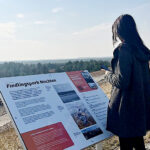Virtual reality (VR) has gone from the domain of science fiction into the mainstream in recent years, transforming sectors including entertainment to healthcare. Its ability to revolutionize education is now acquiring impetus.
VR is revolutionizing schools and teachers especially in science education as they search for creative approaches to involve digital-native students and close the theory-practice gap.
Outline virtual reality and explain its applications.
Virtual reality is the simulated experience that might be either exactly like or quite different from the real world. Usually, it uses a headgear that envelops the user in a 3D environment so enabling real-time interaction with digital elements.
Users can experience scenarios from a first-person point of view, move across the surroundings, and handle objects.
VR is already rather extensively applied outside of the classroom. Medical students perform procedures in virtual operating rooms in hospitals. In architecture, designers stroll through virtual building models before they are ever built.
Gamers enter large virtual worlds with lifelike graphics and physics in entertainment. All of these programs have as their common thread immersion and interactivity—qualities that can be quite effective in the classroom.
Why Virtual Reality in Education Might Be the Next Frontier
Virtual reality in education marks a major change in the way teachers present materials and students absorb knowledge. Lectures, textbooks, and sporadic hands-on exercises define conventional classroom environments.
Although these strategies have many benefits, they can find it difficult to involve students completely, particularly in relation to abstract or difficult topics including chemistry, physics, or biology. VR presents a chance to bring learning more physical and interactive.
Imagine students seeing real-time oxygen-rich blood flow across arteries as they investigate the human circulatory system from the inside. Alternatively, chemistry students working in a totally safe digital lab on perhaps hazardous reactions.
Deeper knowledge and long-term memory depend on VR transforming students from passive receivers into active participants.
Benefits of VR in Education
Using virtual reality in classrooms offers many benefits. Among the most convincing advantages of VR are its capacity to support active learning, increase participation, and produce unforgettable learning opportunities. Here are a few main advantages:
1. Enhanced Involvement and Motivation
Students that participate actively in their education are more likely to remain involved. VR brings an exciting quality absent from many conventional approaches. Using cutting-edge technology in conjunction with immersive storytelling and interactive surroundings makes courses unforgettable and fun.
2. Enhanced Conceptual Knowledge
Like molecular structures, gravitational forces, or electromagnetic fields, abstract ideas are famously challenging to teach. Often directly manipulating these ideas, VR lets students see them in three dimensions. This spatial interaction makes learning more natural and helps one to grasp.
3. Safe and Understood Environment
Many experiments in disciplines including chemistry or physics include hazards that restrict active student participation. In a real-world classroom, VR lets students run experiments that would be too costly, dangerous, or logistically difficult. Errors become inevitable in the course of learning without any practical repercussions.
4. Individualized Education
One can create VR systems to fit different learning environments by means of design. Immersion graphics help visual learners; kinesthetic learners value interactive simulations. Some sites even provide real-time comments to help students through courses at their own speed.
5. Inclusiveness and Accessibility
VR can provide experiences otherwise unattainable for students with disabilities or those living in remote areas. Virtual field trips, 3D visualizations, and simulated labs help to level the playing field and offer equal learning possibilities.
Useful VR Applications for Science Education
There is nowhere more clear the influence of VR than in STEM education, especially science. These are a few useful approaches VR is now being used in science classrooms:
1. Virtual laboratories for science
Creating virtual labs where students may conduct experiments without using actual materials is one of the most efficient applications of VR. Under a VR helmet, platforms like Futuclass—which provides modules allowing students to balance chemical equations, mix elements to form compounds, or see exothermic reactions—offer These labs provide hands-on experience that supports theoretical knowledge by simulating real-world physics and chemical interactions.
2. Human Biography and Anatomy
Students could investigate the human body in 3D rather than learning diagrams from a textbook by memory. Learners can “walk through” organs, see body processes in action, and even replicate surgical operations using virtual reality. Higher education and medical training, where a better knowledge of anatomy is crucial, benefit especially from this approach.
3. Physics Replays
From grasping Newton’s laws to experimenting with electromagnetism, VR lets students visualize forces, motion, and energy transfer in ways that would be challenging in a conventional lab. Students can, for instance, instantly see how changes in variables like gravity or friction affect outcomes—something impossible in a real-world classroom. This allows them to control those variables.
4. Environmental and Earth Sciences
In environmental science education VR is also creating waves. Students might investigate several ecosystems, see how climate change is affecting things, or go through geological events like earthquakes or volcanic eruptions. These immersive events inspire closer involvement by making world problems feel instantaneous and personal.
5. Discovery of Space
Virtual reality lets students travel across the solar system, land on Mars, or negotiate the International Space Station, so transforming their lessons in astronomy. This not only piques interest but also helps to place difficult astrophysical ideas in a context never possible in textbooks.
Using VR in Education: What More Is Needed?
Although the advantages are obvious, using VR in learning environments does call careful preparation:
- Schools need VR headsets, ideally with high-resolution displays and easy controls. Affordable choices for classroom use are Meta Quest, which provides wireless, stand-alone capability.
- Software and Content: Excellent learning materials are absolutely vital. Curriculum-aligned VR modules especially meant for middle and high school students are offered by external providers.
- Teachers have to be at ease using VR technology and including it into their lessons. Many companies provide onboarding and support to guarantee seamless adoption.
- Important factors also include infrastructure: charging stations, a stable Wi-Fi connection, and an area where students might safely use VR headsets.
- Safety and Monitoring: Schools should create procedures for supervised use, so guaranteeing that sessions are catered to avoid motion sickness or disorientation and that students use the equipment responsibly.
Last Words
Virtual reality in education offers a present-day chance to rethink how we teach and learn, not a futuristic dream. The possibilities to create interesting, significant, and successful learning environments become almost endless as more universities embrace immersive technologies.
Particularly in science education, VR provides a strong means to bring abstract ideas to life, so enabling students to investigate, experiment, and really comprehend the surroundings.
Investing in this transforming technology now will help teachers equip their students for the real-world challenges of tomorrow rather than only for tests.
Quelle:


